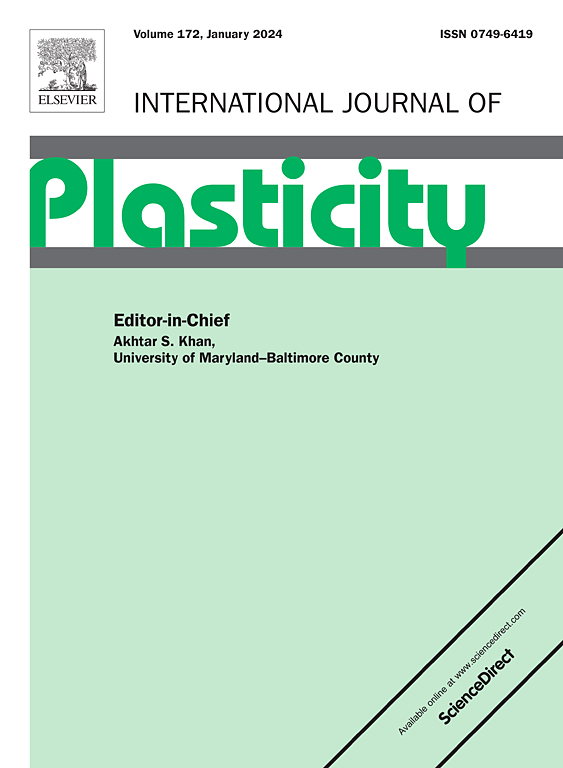Effect of twinning on shear localization of Al0.1CoCrFeNi high entropy alloy at high strain rates: Experiment and crystal plasticity modeling
IF 9.4
1区 材料科学
Q1 ENGINEERING, MECHANICAL
引用次数: 0
Abstract
As one of the most important plastic deformation mechanisms of high-entropy alloys, deformation twinning can increase the strength without losing plasticity. Nevertheless, recent studies have shown that high-density twins can form "soft spots" and promote the occurrence of shear localization failure at high strain rates. The extent to which deformation twins contribute to the formation of shear localization remains unclear. In this study, a series of dynamic uniaxial compression experiments have been performed with Al0.1CoCrFeNi HEAs under different conditions to disclose the dynamic recrystallization mechanism. Corresponding to the dynamic recrystallization and plastic dissipation mechanisms at high strain rates, a dislocation entanglement model has been established in conjunction with deformation twinning and physically based heat dissipation to capture the process of shear localization formation. The dislocation entanglement model has been integrated into the theoretical framework of crystal plasticity to perform finite element simulations of high-strain rate deformations. The results predicted by the crystal plasticity simulations are in good agreement with the experimental data, confirming the rationality of the new constitutive model. Deformation twinning can significantly improve strain hardening ability and resistance to shear localization. Interestingly, when the volume fraction of twins reaches a certain level, the mechanism of twin-assisted continuous dynamic recrystallization is triggered due to the interaction between dislocations and twins, resulting in the formation of many “soft spots” (corresponding to the twin region with high density). Upon further deformation, these “soft spots” continue to evolve and aggregate to eventually form the bands of shear localization. Our results can be used for the microstructure design of dynamic high-performance metals with high strength and plasticity to artificially control shear localization.
孪生对高应变速率下Al0.1CoCrFeNi高熵合金剪切局部化的影响:实验与晶体塑性模拟
变形孪晶是高熵合金最重要的塑性变形机制之一,可以在不损失塑性的情况下提高合金的强度。然而,最近的研究表明,高密度孪晶在高应变速率下会形成“软点”,促进剪切局部化破坏的发生。变形孪晶在多大程度上促成了剪切局部化的形成尚不清楚。本研究对Al0.1CoCrFeNi HEAs在不同条件下进行了一系列动态单轴压缩实验,揭示了动态再结晶机理。针对高应变速率下的动态再结晶和塑性耗散机制,建立了结合变形孪晶和物理散热的位错纠缠模型,以捕捉剪切局部化形成过程。将位错纠缠模型整合到晶体塑性的理论框架中,进行高应变速率变形的有限元模拟。晶体塑性模拟预测结果与实验数据吻合较好,证实了新本构模型的合理性。变形孪晶可以显著提高材料的应变硬化能力和抗剪切局部化能力。有趣的是,当孪晶体积分数达到一定水平时,由于位错与孪晶的相互作用,触发孪晶辅助连续动态再结晶机制,导致形成许多“软点”(对应高密度孪晶区)。在进一步变形后,这些“软点”继续演化和聚集,最终形成剪切局部化带。研究结果可用于高强度、高塑性动态高性能金属的微观结构设计,人为控制剪切局部化。
本文章由计算机程序翻译,如有差异,请以英文原文为准。
求助全文
约1分钟内获得全文
求助全文
来源期刊

International Journal of Plasticity
工程技术-材料科学:综合
CiteScore
15.30
自引率
26.50%
发文量
256
审稿时长
46 days
期刊介绍:
International Journal of Plasticity aims to present original research encompassing all facets of plastic deformation, damage, and fracture behavior in both isotropic and anisotropic solids. This includes exploring the thermodynamics of plasticity and fracture, continuum theory, and macroscopic as well as microscopic phenomena.
Topics of interest span the plastic behavior of single crystals and polycrystalline metals, ceramics, rocks, soils, composites, nanocrystalline and microelectronics materials, shape memory alloys, ferroelectric ceramics, thin films, and polymers. Additionally, the journal covers plasticity aspects of failure and fracture mechanics. Contributions involving significant experimental, numerical, or theoretical advancements that enhance the understanding of the plastic behavior of solids are particularly valued. Papers addressing the modeling of finite nonlinear elastic deformation, bearing similarities to the modeling of plastic deformation, are also welcomed.
 求助内容:
求助内容: 应助结果提醒方式:
应助结果提醒方式:


